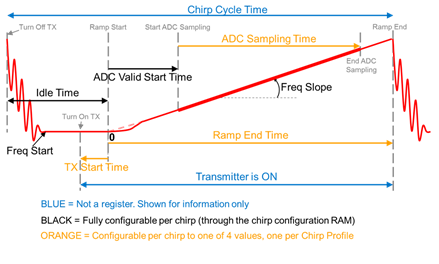Hello,
Let's say I have two IWR6843 units using two TX antennas each placed close to each other. I want to run them both at 10FPS and merge the data from both the units into a single pointcloud. One way to do it would be time multiplexing, where you would simply start the first unit at time=0ms and the next unit at time=50ms.
R1Tx1: _|__|__| ... _|___________
R1Tx2: __|__|__| ... _|___________
R2Tx1: ____________|__|__| ... _|
R2Tx2: _____________|__|__| ... _|
(Each | represents a single ramp)
Another way would be to interleave ramps between the units like this:
R1Tx1: _|____|____| ... _|____|
R1Tx2: ___|____|____| ... _|____|
R2Tx1: __|____|____| ... _|____|
R2Tx2: ____|____|____| ... _|____|
Where Radar 2 transmits during the chirp idle time of Radar 1 and vice versa. I'm thinking this could be done using the SYNC_IN frame trigger mode. As an example, if the time between two chirps is 80µs with maybe a 32µs ramp time and 48µs idle time, I could trigger SYNC_IN on Radar 1 at t=0µs and then trigger SYNC_IN on Radar 2 at t=40µs and they should send their chirps at the appropriate times (I'm assuming the clocks won't drift too much during a single 20ms frame).
There are several benefits with option 2, like having no significant time difference between the frames, and lower total frame time while still having the same velocity resolution as option 1. Do you know of any downsides to using option 2, like if it will have any effects on RF performance? Do you know of any other problems I might run into with option 2?


